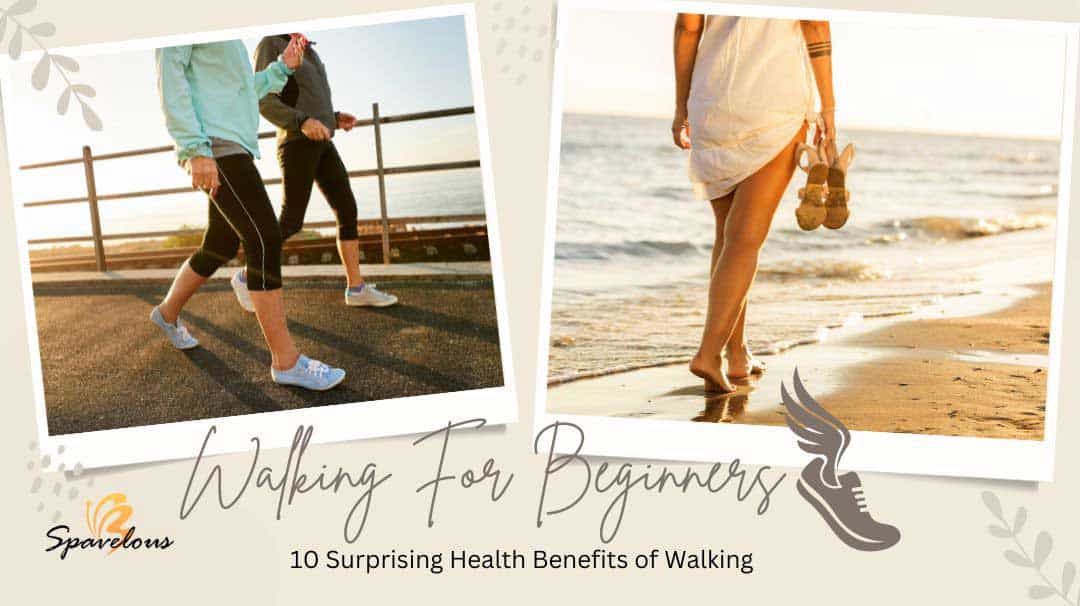Walking For Beginners: 10 Surprising Health Benefits of Walking
Walking for beginners is an easy way to improve your health. Walking is a fundamental human movement that holds immense potential to transform your health and well-being. In this comprehensive guide, we explore the profound effects of achieving the 10,000 steps per day milestone and provide expert insights to help you maximize the benefits while minimizing risks.
Understanding the 10,000-Step Goal
Originally popularized in Japan in 1964 as part of a marketing campaign for a pedometer, the 10,000-step goal has since become widely embraced as a measure of daily physical activity. However, it’s essential to recognize that this figure isn’t a one-size-fits-all solution.
Walking for Beginners: Why Aim for a Daily Walking Goal?
Walking for beginners is an exercise almost anyone can do. You need some decent shoes – no fancy equipment or a pricey gym pass. Going for regular walks provides big health rewards, helping lower your risk of the top 3 causes of death and enhancing other factors in your life.
- Lower Risk Heart disease
- Obesity – Lose weight and become lean
- Walk Away Craving
- Reduce the Risk of Diabetes
- High blood pressure
- Depression/Mood
- Enhance Cognition
- Increased Creativity
- Improve Your Sleep
- Ease Joint Pain
So, aiming for a particular step count daily keeps you focused on maintaining an active lifestyle. Even spread throughout your routine, brisk 10-minute walking sessions lead to impressive long-term health perks. Protect your physical and mental well-being for the future by taking more walks today!

Personalizing Your Step Goal
Assessing Your Baseline
Before setting a step goal, it’s crucial to establish your current activity level. The average American walks approximately 3,000 to 4,000 steps per day, serving as a baseline for many. Tracking your daily steps for a week provides valuable insights into your typical activity patterns.
Incremental Progress
Rather than striving to reach 10,000 steps immediately, aim for gradual progress. Start by adding 1,000 extra steps every two weeks until you reach your desired goal. This incremental approach allows for sustainable behavior change and reduces the risk of burnout or injury.
Heart Health and Walking: A Lifesaver
Walking just 30 minutes a day can significantly reduce the risk of heart disease. Walking gets your blood pumping, strengthening this essential organ. Faster walking paces have been linked to lower cardiovascular disease risks, with postmenopausal women seeing a 30% lower risk of heart failure from brisk walking.
A Step Towards Combating Obesity
Walking has a protective effect against obesity, especially for those with a higher genetic predisposition to the condition. Regular brisk walking can significantly reduce the influence of obesity-related genes. Daily Walks burn calories, keeping weight in check. Just 30 minutes of brisk walking per day can stop excess pounds from creeping on over time.
Reaching 10,000 daily steps offers scientifically supported health advantages:
- Burns 20% more calories than 5,000 step days, aiding weight loss.
- Enhances metabolism and energy expenditure long term.
- Providing flexibility for caloric intake while achieving caloric deficit for weight reduction.
Walking Away from Cravings
A brisk 15-minute walk has the power to curb sweet-tooth cravings, providing a simple strategy to manage unhealthy snacking habits.
Walking Helps Prevent and Manage Diabetes
Walking helps control blood sugar levels, reducing this disease’s risk. Physical activity makes your body’s insulin work better. By improving insulin functioning, controlling glucose excursions, reducing systemic inflammation, and regulating appetite-controlling hormones, adopting regular walking routines provides a potent lifestyle remedy for maintaining a healthy blood sugar balance and avoiding diabetes onset.
Walking for Blood Pressure Control
Regular walking sessions have been proven to effectively lower blood pressure and heart rate, offering a simple exercise solution for cardiovascular health maintenance. Moving every day keeps arteries flexible and reduces hypertension. Combining walks with diet improvements helps.
Boosting Your Mood with Every Step
The act of walking for beginners can elevate mood and decrease stress levels. Regular walks, especially in nature, have been shown to alleviate symptoms of anxiety and depression. Getting outside daily and exercising gives both mood and energy levels a boost. Natural sunlight and movement release feel-good endorphins.
Enhancing Cognitive Functions
Regular walking routines stimulate blood flow to the brain. They are beneficial for brain health, improving decision-making processes, memory, creativity, and cognitive functions, thereby slowing down cognitive impairment in older adults.
Creative Thinking on the Go
Walking has been associated with increased creativity and the generation of new ideas, echoing the practices of figures like Steve Jobs and Friedrich Nietzsche.
Improving Sleep Quality Through Walking
Evening walks, performed at a gentle pace, can help enhance sleep quality, aiding in faster sleep onset and improved sleep duration.
Easing Joint Pain
As a low-impact exercise, walking helps maintain joint flexibility, reduces the risk of stiffness or discomfort, strengthens muscles, and alleviates pressure on the joints, reducing pain and discomfort. It’s particularly beneficial for your knees and hips.
Walking For Beginners: The Ideal Daily Step Count
Contrary to popular belief, the magical 10,000-step count is more a marketing gimmick than a scientifically backed target. Studies suggest walking for beginners can see benefits start from as few as 4,400 steps per day, with health advantages increasing with more steps, peaking at around 7,500 steps. However, there appears to be no upper limit to the benefits, with continuous improvements observed in individuals walking up to 20,000 steps daily.
Customizing Your Daily Step Target
When establishing your own step count goals, consider these Walking For Beginners key factors:
- Baseline activity level – Use a fitness tracker for 1 week without intentionally increasing your movement to determine your current baseline number of steps.
- Age and fitness level – Older adults, previously inactive people, and those managing chronic health conditions may aim for lower daily steps to start.
- Incremental progression – Increase your target by 1,000 steps every 2 weeks until reaching your goal to allow your body to adapt without overexertion or injury.
- Desired health objectives – Focus on step counts scientifically shown to aid specific health goals like weight loss, heart health, strengthening muscles, etc.
With an average sedentary lifestyle tallying only 3,000-5,000 steps per day, adding an extra 5,000 steps marks a significant increase in daily physical activity for most people.
Integrating Walking into Your Daily Life
Simple adjustments can significantly boost your step count: parking farther from your destination, opting for stairs over elevators, or incorporating walking meetings into your work routine. Breaking up your walking goals into smaller, manageable segments throughout the day can also help in achieving your daily step targets.
Top Twelve Techniques to Get More Steps In:
- Schedule your walks on your calendar, just like you schedule workouts. Decide when you’ll go for a walk each day.
- Take a 15-minute walk on your lunch break if you work in an office.
- Take phone calls while walking instead of sitting. Walk around your backyard or in a circle.
- Walk around whenever you have to wait.
- Incorporate walks into activities you already do, like listening to audiobooks or podcasts. The time will fly by.
- Morning or evening constitutional ritual to take a walk after breakfast or dinner.
- Combined with social time by walking with friends.
- Using walking desks or treadmills at work.
- Active commute via walking/biking when possible.
- Taking regular 5-10 minute walking breaks.
- Parking farther and using stairs whenever possible.
- Scheduling walking meetings into the work calendar
The Takeaway: Choose Your Own Optimal Number
In summary, while 10,000 presents a worthwhile step target for better health, staying flexible based on your unique needs is key. Start low and progress intentionally. Consistency matters more than a rigid number. By discovering your minimum effective dose for achieving benefits, you’ll sustain positive steps for life.
FAQs
Q: How much walking is necessary to improve heart health?
A: Walking 30 minutes a day, five days a week, is associated with a significant reduction in heart disease risk.
Q: Can walking replace other forms of exercise in terms of health benefits?
A: While walking offers numerous health benefits, it’s best to incorporate a variety of exercises for overall fitness. However, for many, walking is a highly effective and accessible form of exercise.
Q: How can I make walking a more integral part of my daily routine?
A: Consider creative strategies such as walking meetings, using stairs, and incorporating evening walks to effortlessly increase your daily step count.
Sources:
- Mayo Clinic
- Arthritis Foundation
- NIH News In Health
- American Heart Association
- Center for Disease Control



